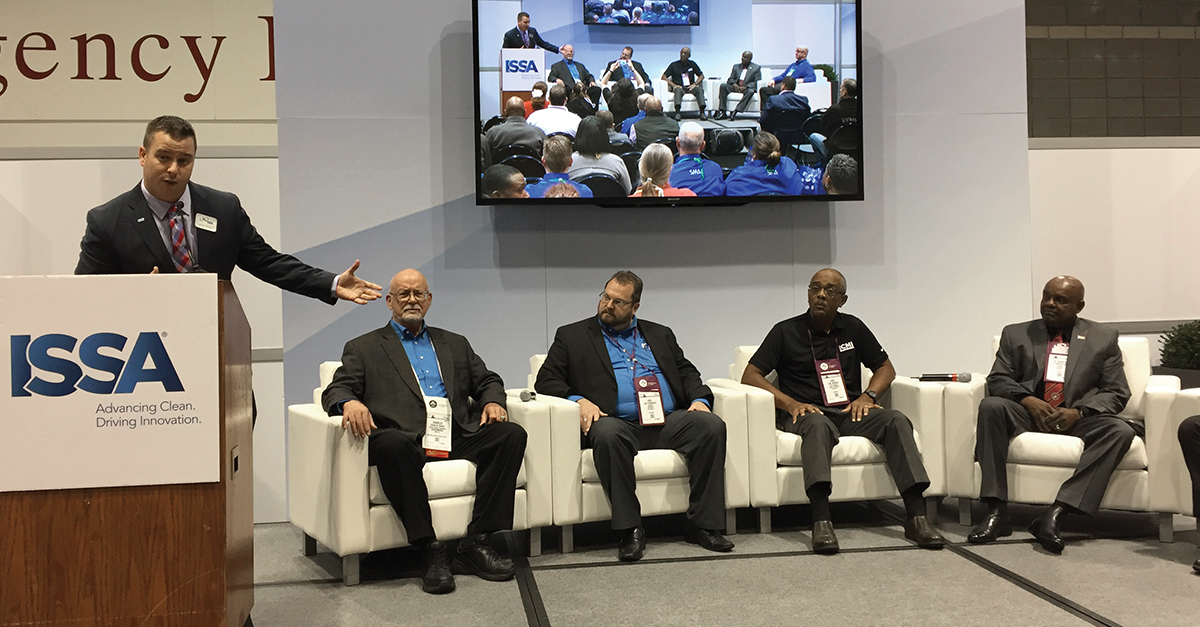There are countless hurdles to jump over when it comes to training a top-notch custodial team: language barriers, technology developments, and worker safety are just a few. Sometimes the challenges arise before the training even begins, such as trying to demonstrate a return on investment for training to management.
The challenges related to training are endless, and sometimes facility managers and building services contractors don’t know where to begin when it comes to tackling them. However, during ISSA/INTERCLEAN®North America 2016, a handful of top industry experts provided some solutions for conference attendees who were looking for answers. The panel discussion featured Bill McGarvey, Marion Ivey, Carl Bowman, Joel Craddock, and Mickey Crowe—all master trainers with the Cleaning Management Institute (CMI)—in addition to moderator Brant Insero, ISSA’s director of education, training, certification, and standards.
Below are five questions—with answers from CMI master trainers—that were featured during the CMI trainer panel, covering topics that impact our staff, our budgets, and our buildings.
Question No. 1: What is the return on investment for training staff?
Joel Craddock: With training people right the first time, the only turnover that we have within our organization is the people who aren’t going to cut the mustard. When you show people why cleaning jobs are important, all of a sudden you’re getting exactly what you want, and you’re getting the results and your clients are happier.
When my wife and I started [our] company… we started understanding the importance of having people that were better trained, because better-trained people don’t turn over. They provide a higher-level service; you have fewer customer complaints; you have a lot less asset damage. When I sit down even with my insurance companies, I can show them all the work we do, all the hours we put in, the billing, and I actually get a break on my insurance as part of it. But the better thing is, [due to] the quality of the individuals we have working for us, we have competitors in our marketplace that are actually referring us for very large jobs because our reputation precedes us [due to] the education that’s backed with our company.
Mickey Crowe: How many of you have money budgeted for overtime to redo work? We don’t do that. And yet, we do spend a lot of time redoing work because the worker wasn’t trained or wasn’t supervised or wasn’t equipped correctly. So the bottom line with training is—whether you keep the metrics or not—it will benefit you, and also, it can open up doors. If you have a bad reputation for doing poor work, that phone isn’t going to ring. You’re not going to get that opportunity to grow. So please understand that the very main reason, the most selfish reason for training is to increase your bottom line and actually help you survive during the hard times.
Question No. 2: What advice would you give on how to get buy-in from a union?
Carl Bowman: The best thing to do is bring them in initially when you start to talk. Don’t wait until you have everything lined up and then spring it on them. Bring them in early and talk to them about [it. Say:] “OK, here’s what we’re trying to do; here’s what we’re trying to get the employees to do.” And as it turned out [for us], it was a win-win for both sides. Our employees got a small bump in salary, and our management folks got a better quality clean in the buildings that we had.
Question No. 3: How do you handle training of employees who face language barriers?
Joel Craddock: Currently, we don’t have anybody in our organization who speaks anything other than English, but we do have several people who do have challenges with reading. One of the things we do with training is we color code everything and train them through the color-coding process. So with microfibers, we use the red ones on toilets and urinals, because we figure that red is like a stop sign. We use the color orange for the sinks in the restrooms because it’s caution: a very high germ area. Yellow, which usually means yield, we use in kitchens and cafeterias, for that very reason: [they’re] more cautionary areas. And then the green—a lot of neutral cleaners and all-purpose cleaners are the [color green]—we use that for all the open offices, and blue is glass. We try to color code the chemicals, as well, when we can.
Question No. 4: What about employees who speak a language other than English?
Brant Insero: You really want to slow down the training process for those individuals if you’re [facing] that circumstance. And also try to find somebody who can provide the training in that specific language, if possible.
Bill McGarvey: We don’t have that large of a call for training people in other languages, but a lot of the manufacturers’ support materials will address [language and literacy barriers], so we do tend to lean on those materials where and when we can, and then we’ll have someone interpret for us. We just doubled the length of the training program, becausewesay it, then we have theinterpretersay it; but we try to stress the number systems, the color coding, things like that, so we can try to reach across those barriers.
Question No. 5: There’s a big demand now for online learning platforms in the cleaning industry. What is your feeling about using online tools for training in the custodial field?
Bill McGarvey: The online training is good; it’s necessary. It certainly addresses that quick snapshot of information for refresher training or [when you want to go over a process again to make sure the employee is on the right track]. I don’t know that it’s necessarily going to replace that one-on-one, in-person, hands-on training that is so critical. The hands-on also addresses some of those language barriers.
It’s the new revolution, really, to have that mobile platform so that we can go out and do training with just one or two people, but we still need to be able to get in front of people on a larger scale for the real nuts and bolts training.
For the real nuts and bolts, it’s hard to lean on just one manufacturer, because they know that product, but they may not know how that product interacts with other equipment or other processes. That leadership role in training has to pull all the pieces together for the trainee, and deal with [his/her] ability to learn and how [he/she absorbs] that knowledge and then actually puts it to work on the front line.
Mickey Crowe: We all learn differently. Three ways: audio, visual, and kinesthetic or hands-on. A lot of the new technologies can really reinforce something you have taught [employees] hands on, and then they see the video or they hear the [recording].
Don’t lock yourself into any one format. Look at the individual. How does he or she learn? And then change your training style and method to meet [his/her] needs. Rather than saying, “You’ve got to come to me,” you go to [him/her] and provide [training]. You have to understand the recipient and be able to give the person the best training based on how [he/she takes] in information.
The complete CMI Trainer Panel, featuring even more answers from cmi master trainers to tough training questions, is available to view atwww.issa.com/live.



